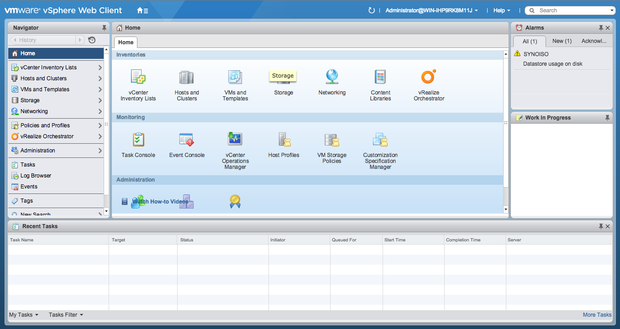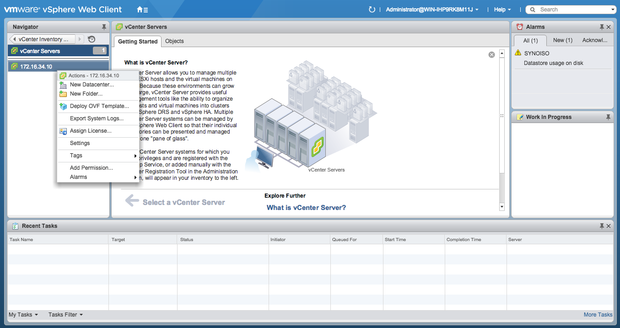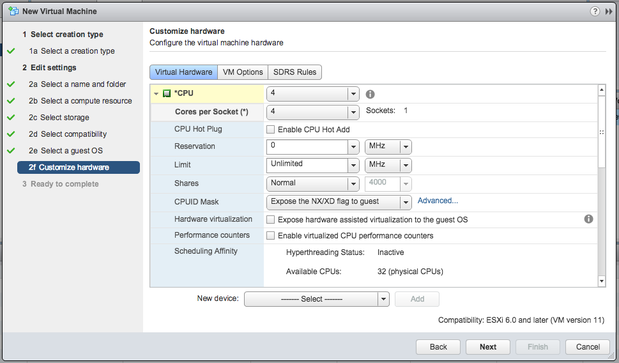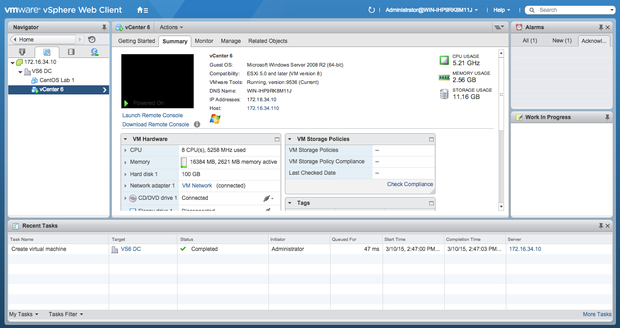First look: VMware vSphere 6 keeps its edge
With welcome improvements to key features, as well as the bundling of backup and recovery, the leading virtualization platform doesn't disappoint

VMware
In the not so distant past, VMware held a long and commanding lead in the server virtualization space, offering core features that were simply unmatched by the competition. In the past few years, however, competition in virtualization has been fierce, the competitors have drawn near, and VMware has been left with fewer ways to distinguish itself.
竞争可能已经经过多年的成长,和VMware可能不太喜欢大铅,因为它曾经那样 - 但它仍享有领先地位。与对数的关键特性,以及功能,诸如备份和恢复了以前单独提供的捆扎有用的改进,则vSphere 6是一个值得加成到vSphere线。这就是说,一些在这个版本的重大进展,如长距离的vMotion,将最为重要较大的vSphere商店。
Big changes in vSphere 6
The big changes in vSphere 6 revolve around expanded resource limits, enhanced vMotion capabilities, a more complete version of the Linux-based vCenter Server Appliance, storage offloading, and enhancements to the Web client. In addition, VMware has bundled extra technologies into vSphere 6, such as the vCenter Director content library that is used to store ISO images, templates, scripts, OVF files, and other elements, and to automatically distribute them across multiple vCenter servers. The Data Protection Advanced backup and recovery tools are now included as well.
VMware vSphere 6 offers advances in the previously existing Fault Tolerance feature. Fault Tolerance is the technology by which a single VM can have presence on multiple physical servers simultaneously. Should the physical server running the active instance fail, the secondary instance is immediately activated. Without Fault Tolerance, the VM could be automatically restarted on another host, but would require time to detect the failure and boot on the new host. With Fault Tolerance, that step is avoided.
In previous versions of vSphere, Fault Tolerance supported only a single vCPU per VM and four fault-tolerant VMs per host. In vSphere 6, the limits are now four vCPUs per VM and either eight vCPUs or four VMs per host.

The main screen of the new vSphere Web Client looks much more like the Windows client than in previous versions. Note the Recent Tasks window at the bottom.
长距离的vMotion
The vMotion improvements will be more germane to those with multiple data centers spread over wide geographic areas. Prior to vSphere 6, live-migrating VMs over large distances was problematic and required high bandwidth and low-latency connections to succeed. In vSphere 6, the network tolerances have been extended, and vMotions can now be completed over links with 100ms latency or less, requiring 250 megabits of bandwidth per vMotion.
此外,虚拟机可以进行vMotion的vCenter服务器之间,并与一个适当的下层基础结构,vMotions可以在不常见的共享存储完成。有迹象表明,在每一侧都与这些扩展功能,主要是在适当的网络布局的形式,允许每个网络上虚拟机的正常通信的限制。
The ESXi 6.0 hypervisor in vSphere 6 can handle up to 64 physical hosts per cluster, up from 32 hosts, and each instance can now support up to 480 CPUs, 12TB of RAM, and 1,000 VMs. Each VM can now be run with up to 128 vCPUs and 4TB of RAM, with vNUMA hot-add memory capabilities.
VMware vCenter Server improvements
On the management side, the vCenter Server Appliance is now feature-complete, on par with its Windows counterpart. Previously, you could run the Linux-based vCenter Server Appliance and manage ESXi hosts, but some of the more advanced features (notably Update Manager) of the Windows-based vCenter Server were not available. As of vSphere 6, the appliance can handle all the tasks that a Windows installation can. This is significant news to those who prefer to not manage a Windows server to run vCenter.
Those who run vCenter Server on Windows will notice that the installation procedure is simplified, though it takes quite a while to complete. All of the moving parts that make up vCenter Server are installed in a single installer action now, including the new Platform Services Controller, which handles SSO, licensing, and certificate management. vCenter Server can be deployed with all components on a single system, or it can be split across multiple systems with the Platform Services Controller and vCenter Server installed separately.
Both vCenter Server for Windows and the vCenter Server Appliance now use a local PostgreSQL database by default, though external Microsoft SQL Server and Oracle databases are also supported on Windows and Oracle databases on the appliance. The switch to PostgreSQL will be important to those running with local databases on earlier versions of vSphere due to the fact that the limitations of the previous Microsoft database are no longer present; thus, local databases can now support 1,000 hosts and 10,000 VMs.

The vSphere Web Client's right-click context menus are still sluggish at times, but overall faster than before.
A better Web UI
ThevSphere Web Client中的第一个版本速度慢,不完整的,并且几乎没有流体作为Windows客户端,很多用户干脆拒绝使用它。在vSphere 5.5中,我们看到了改进的Web客户端,但它仍然是不完全的独立客户端的水平。在vSphere 6,进一步易用性和速度的改进使得Web客户端更可口,如同加入支持更宽范围的客户端浏览器和操作系统。该客户端集成工具,允许像虚拟机控制台访问重要的特点是现在可用于更多的平台,包括Mac OS X.
在Web UI的用户会注意到它担负着较强的相似性的独立客户端,包括在该显示什么样的行动已经采取了在基础设施内底部的近期任务窗格。此外,通过右键单击可用的上下文菜单更好地摆出来,并在Web客户端的整体导航优于以前的迭代。
成功的Web客户端对VMware是至关重要的. The company has been warning about the impending demise of the stand-alone client for several releases and currently stresses that using the stand-alone client will limit the functionality of vSphere to vSphere 5.0 levels. Features and enhancements from vSphere 5.5 onward are simply not available in the Windows client.

Creating a new VM in vSphere 6 using the vSphere Web Client.
VMware Virtual Volumes
VMware introduces a new storage integration concept with vSphere 6 called Virtual Volumes. This is essentially tighter integration with SAN and NAS devices to manage storage operations at the virtual disk level. Virtual Volumes are designed to eliminate the need to carve out large numbers of LUNs or volumes for virtualization hosts and to offload storage-related operations to compatible arrays, with granularity at the virtual disk level.
This integration includes vSphere Storage Policy Based Management, which uses VMware’s storage API to communicate with storage arrays and connects the administration of VMs and storage through to the vSphere UI. Thus, policies can be created and applied to VMs through vCenter while related functions are performed natively by the arrays.
VMware now includes vSphere Data Protection with vSphere Essentials Plus and higher editions of vSphere 6. This is a VM backup and recovery tool that was previously known as vSphere Data Protection Advanced, a separate option. This tool can be used to provide application-aware VM backup and restoration, including support for Microsoft SQL Server, Microsoft Exchange down to the mailbox level, and other popular databases and applications.

The VM overview screen in the new vSphere Web Client.
Up from vSphere 5.5
通过vSphere 6,VMware提供的是现在捆绑在一起,而不是单独的产品欢迎要素的集合,推进了一些预先存在的功能,并简化了安装过程。Web客户端可能仍然会超过那些少数牢骚已经使用独立客户端谁从一开始,但它比以前的迭代更好的显著。
The advances in vMotion and other cross-site features are of limited use to shops not running multiple interconnected data centers with sufficient dedicated bandwidth to support those features. But as VMware increases the tolerances to lower bandwidth and higher latency, the viability of introducing such features grows.
There’s no mistaking the fact that VMware continues to hold the leadership role in server virtualization, but as the feature sets of the top vendors continue to converge and competing solutions continue to get more robust, we may see more of this feature bundling and simplified licensing in the future. For now, vSphere 6 maintains its place as the cream of the crop.
This story, "First look: VMware vSphere 6 keeps its edge" was originally published byInfoWorld .
版权©2015Raybet2









